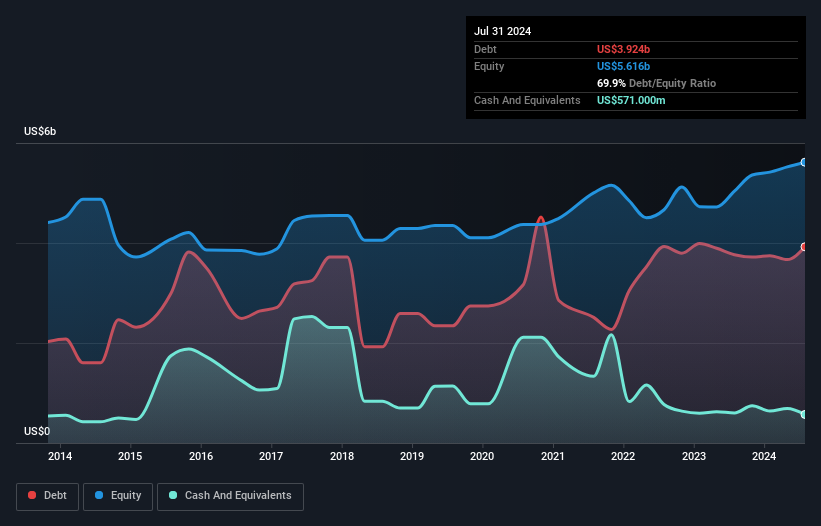- United States
- /
- Trade Distributors
- /
- NYSE:FERG
Ferguson Enterprises (NYSE:FERG) Seems To Use Debt Quite Sensibly

Warren Buffett famously said, 'Volatility is far from synonymous with risk.' When we think about how risky a company is, we always like to look at its use of debt, since debt overload can lead to ruin. As with many other companies Ferguson Enterprises Inc. (NYSE:FERG) makes use of debt. But is this debt a concern to shareholders?
When Is Debt Dangerous?
Generally speaking, debt only becomes a real problem when a company can't easily pay it off, either by raising capital or with its own cash flow. If things get really bad, the lenders can take control of the business. However, a more frequent (but still costly) occurrence is where a company must issue shares at bargain-basement prices, permanently diluting shareholders, just to shore up its balance sheet. Of course, plenty of companies use debt to fund growth, without any negative consequences. The first step when considering a company's debt levels is to consider its cash and debt together.
See our latest analysis for Ferguson Enterprises
What Is Ferguson Enterprises's Net Debt?
You can click the graphic below for the historical numbers, but it shows that as of July 2024 Ferguson Enterprises had US$3.92b of debt, an increase on US$3.77b, over one year. However, because it has a cash reserve of US$571.0m, its net debt is less, at about US$3.35b.

How Strong Is Ferguson Enterprises' Balance Sheet?
According to the last reported balance sheet, Ferguson Enterprises had liabilities of US$5.22b due within 12 months, and liabilities of US$5.74b due beyond 12 months. Offsetting this, it had US$571.0m in cash and US$3.60b in receivables that were due within 12 months. So its liabilities total US$6.78b more than the combination of its cash and short-term receivables.
Since publicly traded Ferguson Enterprises shares are worth a very impressive total of US$39.1b, it seems unlikely that this level of liabilities would be a major threat. But there are sufficient liabilities that we would certainly recommend shareholders continue to monitor the balance sheet, going forward.
We use two main ratios to inform us about debt levels relative to earnings. The first is net debt divided by earnings before interest, tax, depreciation, and amortization (EBITDA), while the second is how many times its earnings before interest and tax (EBIT) covers its interest expense (or its interest cover, for short). Thus we consider debt relative to earnings both with and without depreciation and amortization expenses.
Ferguson Enterprises has a low net debt to EBITDA ratio of only 1.1. And its EBIT easily covers its interest expense, being 14.8 times the size. So you could argue it is no more threatened by its debt than an elephant is by a mouse. On the other hand, Ferguson Enterprises saw its EBIT drop by 4.7% in the last twelve months. That sort of decline, if sustained, will obviously make debt harder to handle. The balance sheet is clearly the area to focus on when you are analysing debt. But ultimately the future profitability of the business will decide if Ferguson Enterprises can strengthen its balance sheet over time. So if you want to see what the professionals think, you might find this free report on analyst profit forecasts to be interesting.
Finally, a business needs free cash flow to pay off debt; accounting profits just don't cut it. So we clearly need to look at whether that EBIT is leading to corresponding free cash flow. During the last three years, Ferguson Enterprises produced sturdy free cash flow equating to 56% of its EBIT, about what we'd expect. This free cash flow puts the company in a good position to pay down debt, when appropriate.
Our View
Happily, Ferguson Enterprises's impressive interest cover implies it has the upper hand on its debt. But truth be told we feel its EBIT growth rate does undermine this impression a bit. All these things considered, it appears that Ferguson Enterprises can comfortably handle its current debt levels. Of course, while this leverage can enhance returns on equity, it does bring more risk, so it's worth keeping an eye on this one. When analysing debt levels, the balance sheet is the obvious place to start. But ultimately, every company can contain risks that exist outside of the balance sheet. We've identified 2 warning signs with Ferguson Enterprises , and understanding them should be part of your investment process.
When all is said and done, sometimes its easier to focus on companies that don't even need debt. Readers can access a list of growth stocks with zero net debt 100% free, right now.
New: AI Stock Screener & Alerts
Our new AI Stock Screener scans the market every day to uncover opportunities.
• Dividend Powerhouses (3%+ Yield)
• Undervalued Small Caps with Insider Buying
• High growth Tech and AI Companies
Or build your own from over 50 metrics.
Have feedback on this article? Concerned about the content? Get in touch with us directly. Alternatively, email editorial-team (at) simplywallst.com.
This article by Simply Wall St is general in nature. We provide commentary based on historical data and analyst forecasts only using an unbiased methodology and our articles are not intended to be financial advice. It does not constitute a recommendation to buy or sell any stock, and does not take account of your objectives, or your financial situation. We aim to bring you long-term focused analysis driven by fundamental data. Note that our analysis may not factor in the latest price-sensitive company announcements or qualitative material. Simply Wall St has no position in any stocks mentioned.
About NYSE:FERG
Ferguson Enterprises
Distributes plumbing and heating products in the United States and Canada.
Adequate balance sheet with acceptable track record.
Similar Companies
Market Insights
Community Narratives



